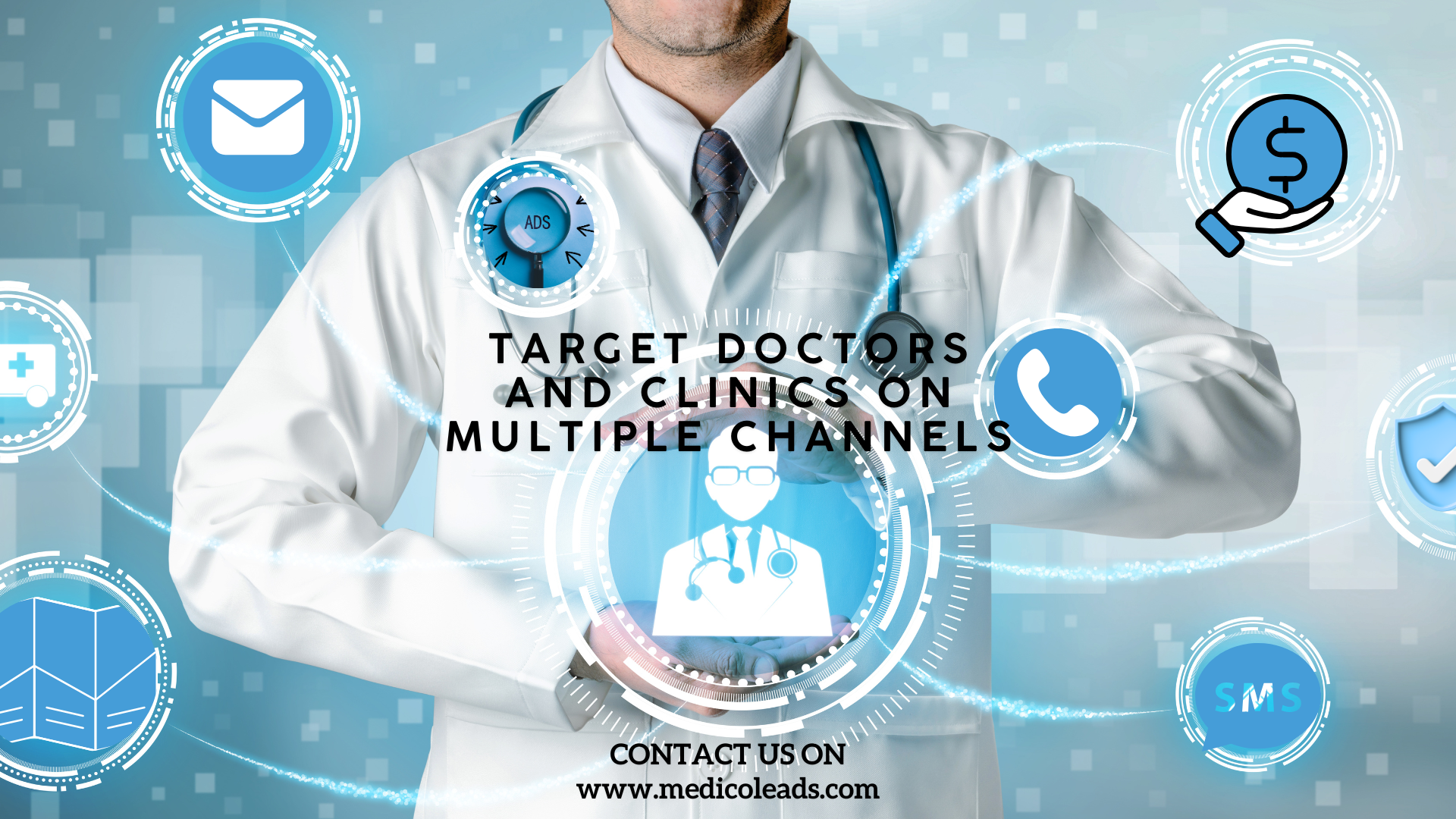Healthcare marketing involves promoting products, services, or solutions to healthcare professionals, such as doctors, clinics, and hospitals, using targeted strategies to improve patient care, streamline operations, or enhance business efficiency.

TABLE OF CONTENTS
Healthcare marketing is unique—it’s not like other B2B sectors. When you’re trying to reach doctors, clinics, or medical decision-makers, you need more than just basic outreach. These are busy professionals, often overwhelmed, and they expect your message to be clear, relevant, and trustworthy.
If your message isn’t spot-on, it’s getting ignored. That’s where accurate targeting, solid data-backed messaging, and reliable contact lists come in. Partnering with medical leads providers , helps you hit the mark with the right audience, the right way.
In this guide, we’ll walk you through how to effectively engage healthcare professionals, avoid common mistakes, and run campaigns that actually work. Ready to start seeing results? Let’s dive in.

1. Understanding the Healthcare Audience
Before launching your healthcare marketing campaign, it’s important to know who you’re targeting. Doctors and clinics don’t respond to generic B2B marketing messages—they want relevance and precision.
1.1. Who Are You Marketing To?
Your audience in healthcare isn’t just doctors. It includes:
- Private practice physicians: Independent decision-makers focused on solutions that save time and improve patient care.
- Group clinics and specialty centers: They value operational efficiency and compliance due to their multi-layered decision-making.
- Hospital procurement teams: These teams care about long-term value, vendor reliability, and sticking to institutional protocols.
1.2. What Motivates Doctors and Clinics?
Healthcare professionals prioritize solutions that enhance their prospect outcomes and streamline their workflows. ROI is a key factor, especially for hospital administrators. Compliance with regulations and ethical standards is essential, as is building trust and credibility.
Tailor your message to each segment for better engagement and results.
2. Building a Strategic Healthcare Marketing Plan
A solid healthcare marketing strategy starts with understanding your audience. Whether you’re targeting doctors, clinics, or hospitals, your strategy needs to align with their unique needs. Let’s break down the key components of a successful strategy:
2.1. Define Your Value Proposition for Healthcare Professionals
Explain how your product or service makes life easier for healthcare professionals—whether it’s improving patient care or streamlining operations.
2.2. Segmenting Your Target List
Don’t use a one-size-fits-all approach. Focus on factors like specialty, location, and practice size. Using accurate contact data ensures you’re reaching the right audience and improving your ROI.
2.3. Setting Measurable Goals
Clearly define your campaign objectives—lead generation, brand awareness, or conversions. Track key metrics to measure success and adjust your strategy for better results.
Building a plan with these steps will ensure your marketing efforts are more focused and effective.
3. Choosing the Right Marketing Channels for Doctors and Clinics
Choosing the right channels for B2B healthcare marketing is extremely crucial. Since doctors and clinics are often busy and overwhelmed with information, it’s important to meet them where they’re most likely to engage. A strategic mix of both digital and traditional methods ensures maximum outreach and impact.
To create the most effective strategy, consider the following channels that resonate well with healthcare professionals:
3.1. Email Marketing Campaigns
Email is a cost-effective way to connect with healthcare professionals. Personalize your messages based on specialty and location to increase engagement. Timing matters too—early mornings or late evenings often result in better open rates. And don’t forget compliance to maintain trust.
3.2. Paid Ads and Retargeting
Paid ads on platforms like Google and LinkedIn are great for targeting healthcare professionals. Retargeting can bring back prospects who’ve interacted with your brand, boosting visibility and engagement.
3.3. Print and Direct Mail
While digital marketing dominates, print materials like postcards and brochures still have impact. Personalized mail cuts through digital fatigue, leaving a lasting impression. When paired with targeted data, print adds credibility and complements digital efforts.
Pro-tip: To maximize the effectiveness of your marketing efforts, always analyze the performance of each channel.
4. Content Marketing for Healthcare Decision Makers
Content plays a crucial role in establishing trust. Physicians and clinic admins want to engage with brands that show expertise and offer real value. By creating content that addresses their specific needs and pain points, you can position your brand as a trusted resource.
Here are a few effective content strategies that can help you build those crucial relationships:
4.1. Webinars and Virtual Events
Hosting webinars on topics such as workflow optimization or new tech is a great way to connect with C-level decision-makers. These events allow deeper connections and position your brand as a trusted resource.
4.2. Blogging for SEO and Authority
An SEO-optimized blog ensures that your content ranks higher on search engines, increasing its visibility to a larger audience. By strategically using relevant keywords, improving load speed, and providing valuable information, it helps attract organic traffic and build credibility.
4.3. Leveraging Data and Technology in Healthcare Marketing
Data and technology are changing how we market to healthcare professionals. Using the right tools can make your outreach more efficient and impactful.
Automation tools, like CRMs and email campaigns, help streamline communication with physicians and clinics. These tools nurture leads and track engagement in real time, saving your team time and boosting ROI.
4.4. The Role of Data Accuracy
Accurate, compliant data is essential for your success. By using verified physician contact lists, you can ensure your messages reach the right audience while staying fully compliant with regulations.
Remember, poor data quality can not only affect your outreach but also damage your brand’s credibility, so make sure you’re working with reliable, up-to-date information.
Are you a marketer who wants to target doctors in hospitals and clinics?
Get started today to optimize your outreach and drive meaningful connections with the right audience.
Partner with MedicoLeads5. Personalization and Relationship Building
Personalizing your approach is key to building a connection with doctors and clinics. Tailored outreach and value-focused content create stronger connections and foster loyalty, making your marketing more effective.
5.1. One-on-One Outreach and Account-Based Marketing (ABM)
Account-Based Marketing (ABM) focuses on high-value accounts, such as group practices, by delivering highly tailored outreach. By addressing each provider’s unique needs, ABM significantly boosts response rates and enhances credibility.
5.2. Building Long-Term Relationships with Clinics
Building long-term relationships with your audience starts with consistent and meaningful communication. Regular follow-ups, newsletters, and content tailored to each specialty will help keep your brand relevant. By staying engaged with your audience, you’ll ensure that you remain top of mind, fostering trust and loyalty over time.
Pro tip: The effectiveness of this strategy is further amplified when supported by accurate, reliable data.
6. Measuring and Optimizing Campaign Performance
Measuring and optimizing campaign performance is considered the holy grail of successful marketing. To make informed decisions and maximize the impact of your campaigns, it’s essential to track the right metrics and constantly refine your approach.
Here are some key areas to focus on:
6.1. Key Metrics to Track
Focus on engagement rates, response times, and lead-to-close ratios to gauge campaign success. These metrics reveal how well your efforts connect with physicians and clinics, helping you pinpoint areas for improvement.
6.2. A/B Testing and Refinement
A/B testing allows you to fine-tune campaigns by testing elements like email subject lines and CTAs. Regular testing, combined with reliable data from email list providers, ensures your messaging is always aligned with your audience’s preferences.
7. Compliance in Healthcare Marketing
Navigating healthcare marketing? Compliance and ethics are key to building trust. Adhering to regulations like CAN-SPAM and GDPR protects sensitive data and keeps you on the right side of the law. Ethical marketing goes beyond compliance—it’s about providing transparent, honest value to healthcare professionals.
Respecting privacy and getting consent when using data are crucial for strong relationships with doctors and clinics. Stay compliant and ethical to safeguard your brand and build lasting trust in this highly regulated industry.
Conclusion: Wrapping Up Your Healthcare Marketing Strategy
To succeed in healthcare marketing, focus on segmentation, personalized outreach, and building trust. Use accurate, compliant data and optimize campaigns for better targeting and ROI.
Audit your current strategy to ensure you’re reaching the right professionals with the right message. Reliable data providers help connect you with verified contacts for smarter, more effective marketing.
Ready to reach verified healthcare professionals? Optimize your outreach with quality data today.
FAQs
How do I reach doctors effectively?
Use targeted email campaigns, personalized outreach, and reliable contact data to ensure your message resonates with doctors. Tools like CRMs and segmentation help refine your approach.
What is Account-Based Marketing (ABM) in healthcare?
ABM focuses on high-value accounts like group practices or specialty clinics, with tailored messaging and outreach strategies that address specific needs, increasing engagement and conversion.
Why is data accuracy important in healthcare marketing?
Accurate data ensures you reach the right decision-makers and comply with regulations. Poor data can harm credibility and waste marketing efforts.
How can I build trust with healthcare professionals?
Offer value-driven content, stay compliant with regulations, and ensure personalized, relevant outreach to foster long-term relationships.
What metrics should I track in healthcare marketing?
Monitor engagement rates, response times, and lead-to-close ratios to evaluate campaign effectiveness and identify areas for improvement.
Is email marketing effective in healthcare?
Yes, personalized email campaigns targeted to specific specialties or locations can drive engagement, especially when timed right and compliant with regulations.
How can I optimize my healthcare marketing strategy?
Use data-driven insights, segment your audience effectively, and continually test and refine your campaigns to improve targeting and ROI.
What is the role of content marketing in healthcare?
Content marketing helps establish your brand as an authority by providing value to healthcare professionals through blogs, webinars, and case studies.
How can MedicoLeads help with healthcare marketing?
MedicoLeads provides accurate, verified contact data, ensuring your outreach reaches the right healthcare professionals and complies with regulations for better targeting and ROI.
Contact Us
